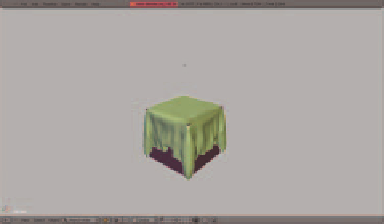Graphics Reference
In-Depth Information
Figure 14.26
The cloth simulation in action
Cloth Pinning
In the case of a curtain or something like a shirt, there will be certain portions of the cloth that will not fol-
low the simulation. The top of a curtain where it attaches to the curtain rod will remain stationary, even if
the wind blows the rest of the fabric. On a character's shirt, you may want the collar and perhaps the area
tucked into the pants to move exactly with the underlying body and not deform as part of the simulation.
These portions of the cloth act as anchors for the rest of the simulation.
This is accomplished by “pinning” portions of the cloth through vertex groups. Revisiting the very simple
example from above, a vertex group can be created for one entire edge of the grid. The
Pinning of Cloth
option is enabled on the
Cloth
panel, and this vertex group is selected, as in Figure 14.27. Running the
simulation then produces the result in Figure 14.28.






Search WWH ::

Custom Search